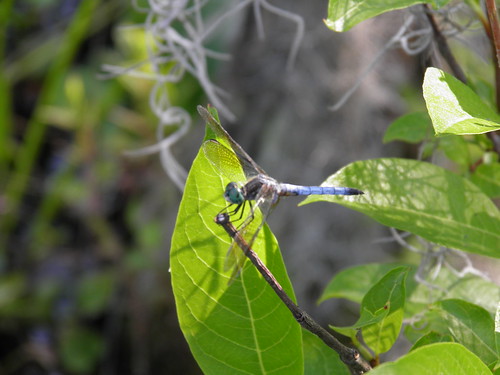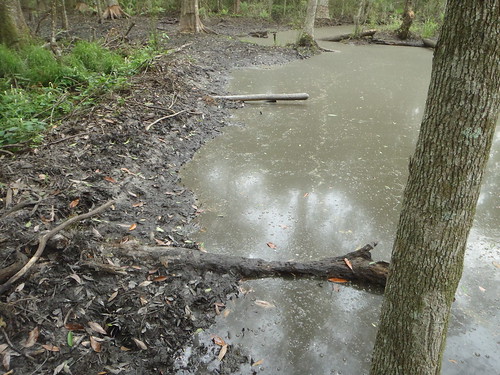And I thought I’d built a garden tool shed for Gretchen: Continue reading
Kinderlou Tower
Gator
Can you see me? Continue reading
Sycamore
Weeded: Continue reading
Looking for Longleaf
 Looking for Longleaf: The Fall and Rise of an American Forest,
by Lawrence S. Earley
Looking for Longleaf: The Fall and Rise of an American Forest,
by Lawrence S. Earley
The tallest and strongest of pine trees, longleaf made great sailing ship masts , tar for caulking ships, and of course saw timber. How the early settlers cut down trees for houses and to clear land to farm. Their hogs and cows running loose in the woods ate the young longleaf, suppressing new trees for a hundred years. Then professional forestry took over, trying to suppress the fire that destroyed northern white pine forests, yet which preserves southern longleaf pine forests. The sad story of turpentine: we knew better, but we did it anyway.
The peculiar life cycle of a tree that starts out looking like a clump of grass, and can stay that way for decades, yet promotes and survives fire and can grow more than 100 feet tall and live for centuries. The thousands of species of plants, animals, and fungi the forest protects, many of them, like wiregrass, also adapted to fire.
How tuberculosis and quail led to new understandings of longleaf and fire, and the people who discovered those things. We do know how to grow these trees now, and lots of people are doing it: for jobs, for sawtimber, for the beauty of the forest.
Skeeter hawk
Monsanto Price Drop
I think that’s CEO-speak for demand is down, competition is up, and Monsanto is retrenching in hopes of saving its core glysophate business. So sad.ST. LOUIS, May 27, 2010 /PRNewswire-FirstCall/ — Monsanto Company (NYSE:MON – News) today announced it is repositioning its Roundup® business in the face of fundamental structural changes that have caused upheaval in the glyphosate industry. Focusing its glyphosate products on supporting the core seeds-and-traits business, the company plans to drastically narrow its Roundup® brand portfolio to offer farmers a simple, quality product that meets their needs at a price closer to generics.
“By reducing the uncertainty associated with Roundup, we free Monsanto to grow on its fundamentals,” Chairman and Chief Executive Officer Hugh Grant said. “What matters to our long-term growth is our seeds-and-traits business, which is on track.”
More clarification from the CEO: Continue reading
Ecology of a Cracker Childhood
I was going to start by posting a short list, but each item was turning into a review, so I’ll just post them one by one as reviews.
 Ecology of a Cracker Childhood (The World As Home),
by Janisse Ray.
Ecology of a Cracker Childhood (The World As Home),
by Janisse Ray.
How dirt poor crackers and corporate greed destroyed most of the most diverse ecosystem in North America; yet these same people are the tragic heroes of the book. Half autobiography, half ecology, this book will either get you with Janisse’s “stunning voice” or you won’t get it. If you’re from around here, you’ll hear the wind in the pines, feel the breeze, and see the summer tanagers yellow in the sun. If you’re not, here’s your chance to meet a “heraldry of longleaf” up close and personal.
“I will rise from my grave with the hunger of wildcat, wings of kestrel….”See Janisse read in Moultrie. “More precious than handfuls of money.” See her wikipedia page for a pretty good bio.
But read the book.
 If nothing else, you’ll never think the same again about Amazon
deforestation once you realize we already did that to ourselves,
and in the south we live in the devastated remnants of what was
one of the most extensive forests on earth, with longleaf pine trees
100 feet tall and 500 years old, maintained by fire, protecting everything from the Lord God bird to the lowly Bachman’s sparrow, from the rattlesnake-eating indigo snake to the beetles that live in gopher tortoise burrows.
The forest can return,
because reforestation can pay.
Meanwhile, there are still places
where you can see how it used to be.
Janisse Ray had a lot to do with preserving Moody Forest, too,
but that’s another story.
If nothing else, you’ll never think the same again about Amazon
deforestation once you realize we already did that to ourselves,
and in the south we live in the devastated remnants of what was
one of the most extensive forests on earth, with longleaf pine trees
100 feet tall and 500 years old, maintained by fire, protecting everything from the Lord God bird to the lowly Bachman’s sparrow, from the rattlesnake-eating indigo snake to the beetles that live in gopher tortoise burrows.
The forest can return,
because reforestation can pay.
Meanwhile, there are still places
where you can see how it used to be.
Janisse Ray had a lot to do with preserving Moody Forest, too,
but that’s another story.
-jsq
Beaver walking
You did this, didn’t you? Continue reading
Lowered Beaver Pond
Why yes, yes it did. You can see one of the pipes underneath the second log. And the water in the beaver pond is clearly lower.
Maybe the beavers won’t
gnaw down as many trees.

Here’s where the water goes: Continue reading








